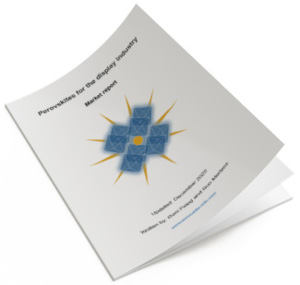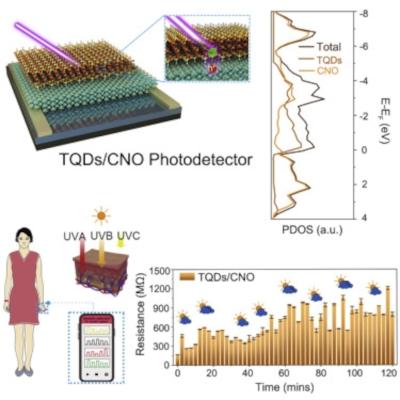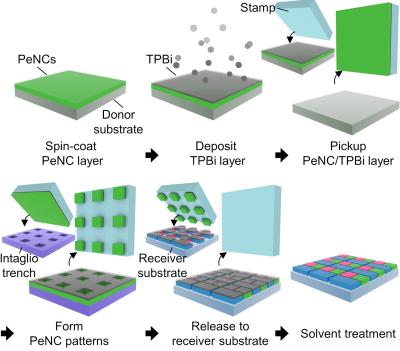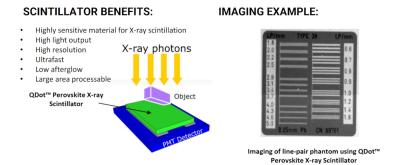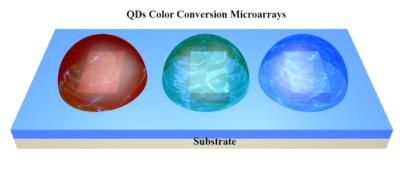Perovskites are materials that share a crystal structure similar to the mineral called perovskite, which consists of calcium titanium oxide (CaTiO3).
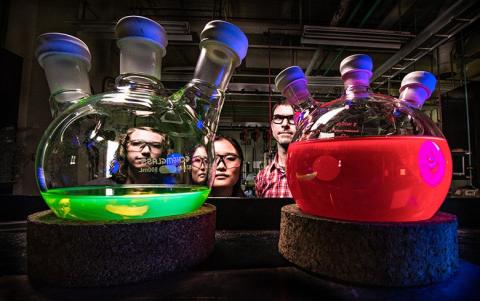
Depending on which atoms/molecules are used in the structure, perovskites can possess an impressive array of interesting properties including superconductivity, ferroelectricity, charge ordering, spin dependent transport and much more. Perovskites therefore hold exciting opportunities for physicists, chemists and material scientists.
Quantum dots (QDs), sometimes referred to as semiconducting nanocrystals (NCs), are miniscule particles of a semiconducting material with diameters in the range of 2-10 nanometers (10-50 atoms). Quantum dots have properties labeled as intermediate between bulk semiconductors and discrete atoms or molecules. Their optoelectronic properties change as a function of both size and shape. QDs demonstrate optical and electronic properties different from those of larger particles. In fact, QDs tend to exhibit quantum size effects in their optical and electronic properties, like tunable and efficient photoluminescence (PL), with narrow emission and photochemical stability. This is why QDs have been incorporated as active elements in a wide variety of devices and applications, some of which are already commercially available, such as QD-based displays.
Perovskite quantum dots (PQDs) are a class of quantum dots based on perovskite materials. While these are relatively new, they have already been shown to have properties matching or surpassing those of the metal chalcogenide QDs: they are more tolerant to defects and have excellent photoluminescence quantum yields and high colour purity. Such attractive properties are extremely suited for electronic and optoelectronic applications and so perovskite quantum dots have significant potential for real world applications, some of which are already emerging, including LED displays and quantum dot solar cells.
Perovskite-Info launches a new edition of its Perovskite for Displays Market Report
Perovskite-Info is proud to announce an update to our Perovskite for the Display Industry Market Report. This market report, brought to you by the world's leading perovskite and OLED industry experts, is a comprehensive guide to next-generation perovskite-based solutions for the display industry that enable efficient, low cost and high-quality display devices. The report is now updated to May 2023, with all the latest commercial and research activity.
Reading this report, you'll learn all about:
- Perovskite materials and their properties
- Perovskite applications in the display industry
- Perovskite QDs for color conversion
- Prominent perovskite display related research activities
The report also provides a list of perovskite display companies, datasheets and brochures of pQD film solutions, an introduction to perovskite materials and processes, an introduction to emerging display technologies and more.
Researchers fabricate full-color flexible microLEDs using perovskite QDs
Researchers from Korea's KIMM institute have fabricated full-color flexible microLED devices, using blue LEDs and perovskite quantum dot color conversion layers. The demonstrated device featured 1 mm pixel pitch LEDs (25.4 PPI) and could be bent with a radius of 5 mm without being damaged.
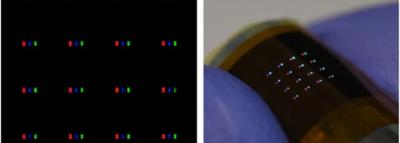
The researchers used a perovskite-QD and siloxane composite using ligand exchanged PQD with silane composite followed by surface activation by an addition of halide-anion containing salt. Due to this surface activation, the researchers say that it was possible to construct the PQD surface with a silane ligand using a non-polar organic solvent that does not damage the PQD. As a result, the ligand-exchanged PQD with a silane compound exhibited high dispersibility in the siloxane matrix and excellent atmospheric stability.
Researchers use perovskite and quantum dots to build an ultraviolet radiation measurement device
A team of researchers from China's Chinese Academy of Sciences (CAS), Jilin University and Beijing Institute of Technology, has used perovskite and quantum dots to build an ultraviolet radiation measurement device.
Measuring the intensity of ultraviolet light in outdoor conditions is important because more intense UV light can lead to faster sunburns and potentially to skin cancer in later years. In this new study, the researchers built a wearable device that can measure ultraviolet radiation in real-time and send the information to a smartphone.
Researchers develop new perovskite-based approach for blue quantum dots synthesis and analysis
Researchers from The University of Tokyo and Yamagata University have addressed the difficulty in creating blue quantum dots by developing a unique self-organizing approach for producing lead bromide perovskite quantum dots. The research also incorporates cutting-edge imaging technology to characterize these novel blue quantum dots.
Quantum dots (QDs) are used in optoelectronic devices and quantum computing, among other things, and are referred to as "artificial atoms" due to their confined and distinct electronic properties. Quantum dots have characteristics that fall in between those of bulk semiconductors and individual atoms and molecules. Their photoelectric qualities vary depending on their size and shape. Quantum dots (QDs) are considered attractive materials for the emissive constituent of light-emitting diodes (LEDs) due to their high color intensity in a small spectral region, facile color tunability, and notable stability. Moreover, QD-based materials exhibit refined colors, longer lifetimes, reduced production costs, and lower energy requirements compared to typical luminescent materials used in organic light-emitting diodes (OLEDs).
Researchers from the University of Japan develop a perovskite-based narrow-spectrum blue QD emitter
Researchers from the University of Tokyo have made progress with the development of blue-emitting quantum dots, which is seen as highly challenging. They have shown that using a new bottom-up design strategy and self-organizing chemistry can help create a high purity blue-emitting QD material (with a narrow emission spectrum).
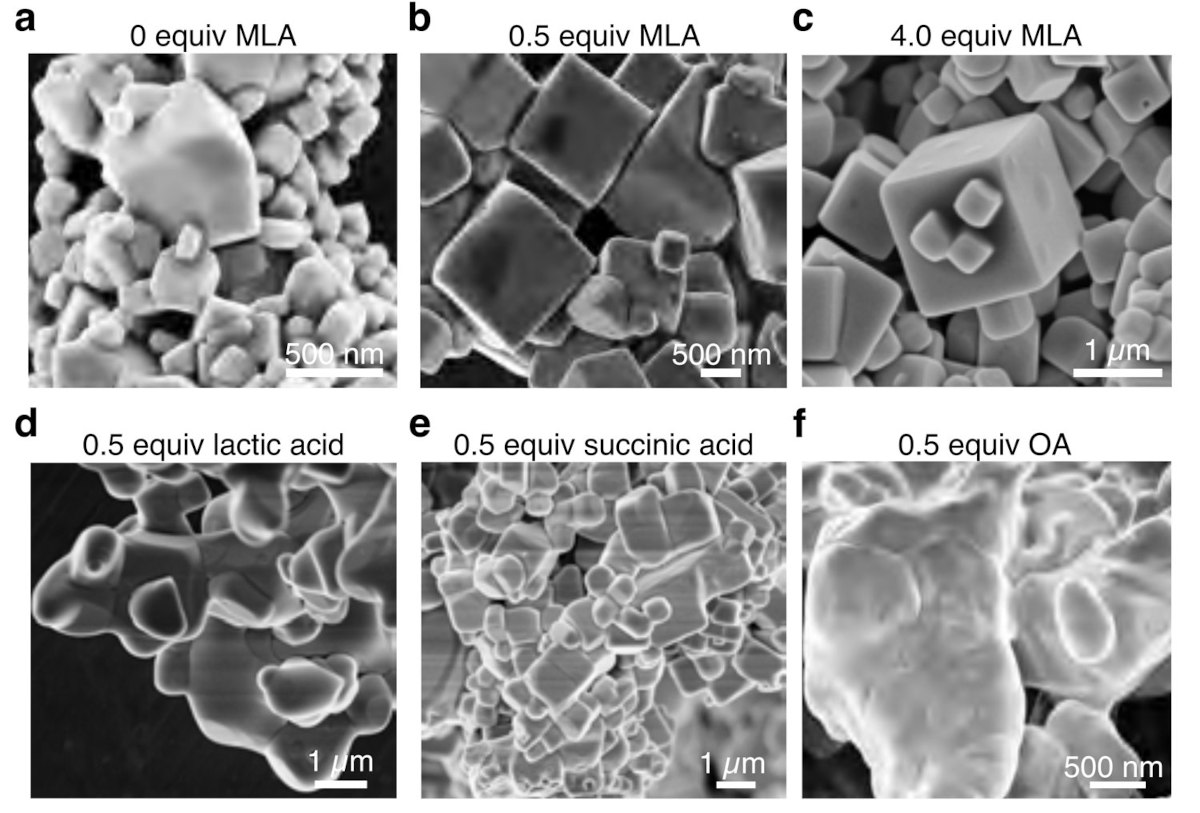
The newly developed QDs have a special chemical composition that combines both organic and inorganic substances, such as lead perovskite, malic acid, and oleylamine. The materials self-aligned into a cube of 64 lead atoms. The lead researcher, Professor Eiichi Nakamura, says that "it took over a year of methodically trying different things to find that malic acid was a key piece of our chemical puzzle".
Researchers develop high-resolution perovskite nanocrystal patterning technique for displays
Researchers from the Ulsan National Institute of Science and Technology (UNIST) have teamed up with researchers from Daegu Gyeongbuk Institute of Science and Technology (DGIST) to develop a patterning technique for the production of perovskite nanocrystal displays which are ultra-thin and high-resolution. The production involves a very simple stamp-like printing process that will facilitate the commercialization of the new technique.
Double-layer transfer printing process with RGB pixelated arrays of PeNCs. Image from Science Advances
The technique reportedly enabled the team to produce a display with RGB pixel patterns of 2,550 pixels per inch, which is about 400 percent higher resolution than the latest high-end smartphones.
Researchers report that lattice distortion of perovskite QDs induces coherent quantum beating
A research team, led by Prof. Wu Kaifeng from the Dalian Institute of Chemical Physics (DICP) of the Chinese Academy of Sciences (CAS), in collaboration with Dr. Peter C. Sercel from the Center for Hybrid Organic Inorganic Semiconductors for Energy, recently reported the utilization of lattice distortion in lead halide perovskite quantum dots (QDs) to control their exciton fine structure.
Shape or crystal anisotropy in QDs results in energy splitting of their optically bright excitons (bound electron-hole pairs), known as fine structure splitting (FSS). For example, the excitons' FSS can be exploited for coherent control of quantum states for quantum computing, or for polarization-entangled photon-pairs in quantum optics, although for the latter it is important to suppress the magnitude of splitting. Studying FSS usually requires single or just a few QDs at liquid-helium temperature, due to its sensitivity to QD size and shape. Measuring FSS at an ensemble-level, much less controlling it, seems impossible unless all the dots are made to be nearly identical.
Great Wall Holdings to build HQ and perovskite base for its spin-off UtmoLight in Wuxi, China
Great Wall Holdings (GWH) has entered a contract to build the headquarters and a perovskite base for its spin-off company UtmoLight in Wuxi, China.
The company signed an agreement with local authorities of Wuxi’s Xishan Economic & Technological Development Zone to invest 3 billion yuan (around USD$442.2 million) in the UtmoLight project. The new headquarters and perovskite innovation industrial base will reportedly house 'the world’s first GW-grade perovskite photovoltaic module and BIPV production line'. The production line of perovskite quantum dot will feature a production capacity of 100 tonnes per year. GWH expects to see an annual production value of 2.5 billion yuan ($368.5 million) after the base is up and running.
Quantum Solutions starts offering evaluation samples of next-gen perovskite-QD based X-Ray Scintillators
UK-based Quantum Solutions started to ship evaluation samples of its next-gen perovskite quantum dots (pQD) X-Ray Scintillators. The company says that these scintillators offer very high sensitivity, high light output, high resolution, low afterglow and can be processed on large areas.
Quantum Solutions started developing these materials in 2020, and already managed to increase the light output (brightness) 10 times over. The company says that this is due to the unique perovskite structure that allows to tune the properties by composition, particle sizes/shapes, ligands, etc. The product already matches the performance of commercial CsI(Tl) and GADOX scintillators. The company is working with key customers in the medical field and non-destructive testing field, and are continuing to develop and customize the product.
Researchers create perovskite quantum dot microarrays for improved displays
Researchers from the Beijing Institute of Technology and MIIT Key Laboratory for Low Dimensional Quantum Structure and Devices have developed perovskite quantum dots microarrays with strong potential for quantum dots color conversion (QDCC) applications, including photonics integration, micro-LEDs, and near-field displays.
QDCC is considered a versatile way to achieve full-color organic light-emitting diodes and micro-light-emitting diodes displays. QDCC provides a wide range of color performance and easy integration. However, conventional QDCC pixels, fabricated by the commonly used method of inkjet printing, tend to be too thin to achieve efficient color conversion. The conventional combination of quantum dots and coffee-ring effects or puddle of particle-laden liquid that occur after evaporation, lowers the light conversion efficiency and emission uniformity in quantum dot microarrays. This also contributes to blue-light leakage or optical crosstalk, where unwanted coupling occurs between signal paths.
Pagination
- Previous page
- Page 3
- Next page
